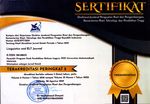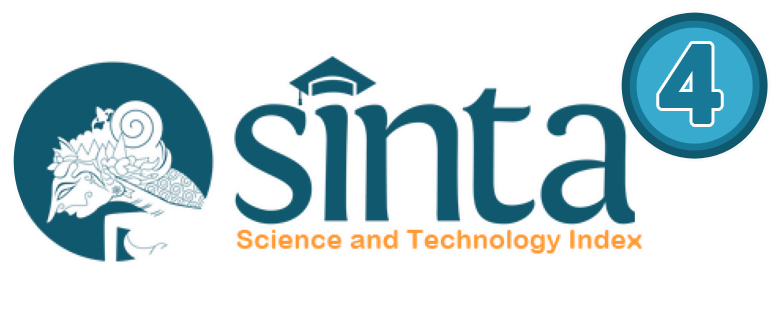THE EFFECTIVENESS OF USING NUMBERED HEADS TOGETHER (NHT) TECHNIQUE IN TEACHING READING COMPREHENSION
Abstract
This research aims at finding out the effectiveness of using numbered heads together in teaching reading comprehension at the first grade students of SMKN 1 Hu’u in academic year 2015/2016. This research is an Experimental study that quasi experimental design with non-equivalent control group design. The populations of this research were 120 students of 6 classes which termed as X.A (experimental class) and X.B (control class) were selected by cluster random sample technique from the first grade students of SMKN 1 Hu’u in academic year 2015/2016. It showed that the mean scores of the experimental class was 31.5 and the mean scores of control class was 7.2. Moreover, it found that the significance value of t-test > than t-table. It was found that t-table 2.042 at the confidence level 0.05 (95%) and 2.750 at the confidence level 0.01 (99%). After the writer compared that score of t-test is 4.40 > than t-table 2.042 at the confidence level of 0.05 (95%) and 4.40 > than t-table is 2.750 at the confidence level 0.01 (99%). And the degree of freedom (df) is n-2=38 from 120 students as the sample of this research. After analysing the data obtained, the writer concluded that the use of numbered heads together technique is effective in teaching reading comprehension. It indicated that the alternative hypothesis (H3) which is read numbered heads together technique is effective in teaching reading comprehension is accepted.
Keywords
Full Text:
PDFReferences
Arikunto, S. (2013). Prosedur Penelitian Suatu Pendekatan Praktek. Jakarta: Rineka Cipta.
Afrilia, R.K. (2012). The Effect of Numbered Heads Together Technique on Reading Comprehension Achievement of the Eighth Grade Students at SMP Negeri 2 Tamanan Bondowoso in the 2011/2012 Academic Year: An Unpublished Thesis of S1 English Language Education Study Program Language and Arts Education Department Faculty of Teacher Training and Education Jember University.
Astuti, M. Y. (2014). The Effectiveness of Numbered Heads Together Technique (NHT) on Students’ Reading Ability: A Quasi-Experimental Study at the Second Grade of SMPN 2 Tangerang Selatan; An Unpublished Thesis of S1 Departement of English Education Faculty of Tarbiyah and Teachers Training Syarif Hidayatullah State Islamic University Jakarta.
Arends I, Richard. (2012) in Mursalin (2014). Learning to Teach, Ninth Edition. New York: M. Grown-Hill.
Arends I, Richard. (2007) in Fithiawati (2014). Learning to Teach, New York: McGraw-Hill.
Birch, B.M. (2002). English L2 Reading: Getting to the Bottom: New Jersey London: California State University-Fresno
Brown, H.D. (2000). Teaching by Principles: An Interactive Approach to Language Pedagogy. New York: Person Education Company.
Brown, H.D. (2003). Language Assessment: Principles and Classroom Practices: California, San Francisco.
Creswell, J.W. (2012). Educational Research: Planning, Conducting, and Evaluating Quantitative and Qualitative Research: (Fourth Edition). New York San Francisco: University of Nebraska–Lincoln. Pearson
Dorn, L. J. & Soffos, C. (2005). Teaching for Deep Comprehension: A Reading Workshop Approach: Stenhouse Publishers.
Huda, M. (2015). Cooperative Learning; Metode, Teknik, Struktur dan Model: PUSTAKA PELAJAR
Harmer, J. (2001). How to Teach English: An Introduction to the Practice of English Language Teaching: England. Pearson Education Limited.
Himmele, P. & Himmele, W. (2011) in Martriwati & Firdaus (2014). Total Participation Techniques: Making Every Student an Active Learner. Alexandria, USA : ASCD product.
Klingner, J. K. et al. (2007). Teaching Reading Comprehension to Students with Learning Difficulties: The Guilford Press a Division of Guilford Publications, Inc.
Leams, K. et al. (2010). Teaching Reading to English Language Learners. Insights from Linguistics: The United States of America.
Mikulecky, B. S. Jeffries, L. (2007). Advanced Reading Power: Extensive Reading, Vocabulary Building, Comprehension Skills, Reading Faster: Pearson Education
Moreillon, J. (2007). Collaborative Strategies for Teaching Reading Comprehension: Maximizing Your Impact: American Library Association
Muladi, T. (2011). Teaching Learning Strategy: A Brief Guide for Future Teacher: Yogyakarta. Data Algonia
Nunan, D. (2005). Practical English Language Teaching: Young Learner. New York: McGraw-Hill Companies.
Pang, E. S. et al. (2003). Teaching Reading: The International Academy of Education—IAE.
Patel, M.F. & Jain, P.M. (2008). English Language Teaching: Methods, Tools & Techniques: Sunrise Publishers & Distributors
Richards, J. C. & Renandya, W. A. (2002). Methodology in Language Teaching: An Anthology of Current Practice: New York: Cambridge University Press.
Ruddel, et al. (2008) in Mardiono (2014). Teaching Children in Today’s Elementary School. The United Stated of America.
Scanlon, D. M. et al. (2010). Early Intervention for Reading Difficulties: The Interactive Strategies Approach: The Guilford Press.
Snow, C. E., (2002). Reading for Understanding toward a Research and Development (R&D) Program in Reading Comprehension. Arlington: RAND Education
Sugiyono, (2014). Metode Penelitian Pendidikan. Pendekatan Kuantitatif, Kualitatif, dan R&D. Bandung. ALFABETA.
Suprijono, A. (2014). Cooperative Learning: Teori & Aplikasi Paikem: PUSTAKA PELAJAR.
DOI: https://doi.org/10.31764/leltj.v3i1.314
Refbacks
- There are currently no refbacks.
Copyright (c) 2018 Linguistics and English Language Teaching Journal

This work is licensed under a Creative Commons Attribution-ShareAlike 4.0 International License.
_____________________________________________________
Linguistics and ELT Journal
p-ISSN 2339-2940 | e-ISSN 2614-8633

LELTJ is licensed under a Creative Commons Attribution-ShareAlike 4.0 International License.
_____________________________________________________
LELTJ is abstracting & indexing in the following databases:
_____________________________________________________
LELTJ Editorial Office:













